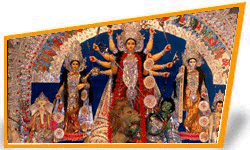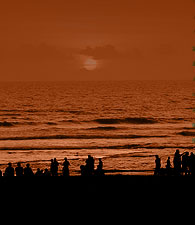History:

Lord Rama, the hero of the Hindu epic, Ramayana.
When Ravana (the 10-headed demon king of Lanka, now Ceylon) abducted
Lord Rama’s wife Sita, and held her hostage in Lanka, a
fierce battle ensued. Although there were huge casualties on both
sides, Ravana could not be defeated. So Rama decided to seek the
blessings of Shakti or Goddess Durga in order to defeat the 10-headed
demon.
Goddess would be pleased only if she was worshipped
with 108 Blue Lotuses. After travelling and searching the whole
world, Lord 'Rama' gathered only 107 Blue Lotuses. So he finally
decided to offer one of his eyes, which resembled Blue Lotuses.
Durga, being pleased with the devotion of 'Rama', appeared and
blessed him for the battle.
Celebrated on:
Durga Puja is celebrated twice a year, once
in the month of Chaitra (April-May) and then in Ashwin (September-October).
On both occasions nine different forms of Goddess Durga is worshipped
threfore called Durga Navratri (nine nights). According to the
Hindu Calendar Durga Puja festival starts on the first day and
ends on tenth day of bright half (Shukla Paksha) of Ashwin month.
Legends of the Festival:
According to a mythological legend attached
to this day, demon Mahishasur vanquished the gods and their king,
Indra, who approached the Holy Trinity, Brahma, Vishnu and Shiva.
They in turn sought the help of the divine mother Durga who, equipped
with lethal weapons, riding a ferocious lion, in all her awesome
majesty, killed Mahishasur. This day, thus, also celebrates the
magnificence and omnipotence of Goddess Durga.
The festival of Durga Puja has its link with
Pandavas. According to the great Indian epic the Mahabharat, the
Pandavas had to spend 12 years wandering in the forest and one
year in camouflaged form. The Pandavas spent their last year in
the court of Virat. On the end of one year Pandavas regained their
arms from the shammi tree and declared their true identification.
It was the day of Vijay Dashmi. Since that day the exchange of
Shami leaves has become the symbol glory and triumph.
Another legend about Durga, she was a manifestation
of Parvati, Shiva’s consort. It seems that while Parvati
existed only for Shiva, Durga was the form of Parvati’s
shakti (power) that was created solely for destroying demoniac
forces.Close to the heart of almost every Bengali is the image
of Durga as the daughter who visits her parents annually. Her
children Lakshmi (Goddess of Wealth), Saraswati (Goddess of Knowledge),
Ganesha (God of Prosperity) and Kartikeya accompany her on this
visit. Each year, there is great rejoicing at the time of her
homecoming, but the air is tinged with sadness on the day one
bids adieu to the deity. Perhaps people identify more intimately
with the human face of the omnipotent Goddess.
Attractions of the Festival:
The onset of autumn signifies the homecoming
of the Mother Goddess and brings with it the aura of festivity
and celebration. There is a Bengali saying that there are 13 festivals
in the Bengali calendar of 12 months. Durga Puja is undoubtedly
the biggest of them all. To say that it is being celebrated with
fanfare and gaiety in this part of the country is an understatement.
Huge idols of the ten-armed Goddess Durga destroying
the ‘Buffalo Demon’ accompanied by her two sons, Lord
Ganesha and Kartikeya, and two daughters Goddess Laxmi and Saraswati
painstakingly created by artisans, mainly at Kumartuli area of
north Kolkata, are placed at the puja pandals (makeshift temples)
erected for the purpose.
The much acclaimed pandals reflect the engineering
skills of the craftsmen. Innovative illumination of these pandals
by the famed electricians of Chandannagar, a suburban town, is
another attraction of the Durga Puja.
Altogether, being in the midst of Durga Puja celebrations in Kolkata
is an unforgettable experience. And why not, the four days of
festivity (though it’s a ten-day festival, the last four
days are celebrated in grandeur), is an experience which one treasures.
The rituals start with ‘Bodhan’
(the invocation of the Mother Goddess on the first day) on Sasthi
and ‘Naba Patrika Sthapan’ (the important ritual of
setting up a giant banana tree clad in a saree beside Lord Ganesha
and worshipping her as his ‘wife’) on Saptami. Then
there is the ‘Pushpanjali’ (floral offerings to the
Goddess) in the morning and the ‘Sandhya Arati’ in
the evening of Ashtami, the most important day of the festival.
And then the animal sacrifice on Nabami (the third day of the
festival and the ninth according to the Bengali almanac) and the
‘Sindoor Khela’ (the ritual of putting vermilion on
the forehead of the Goddess by the married womenfolk). Finally,
the tearful immersion of these huge images on Dashami (the tenth
or the last day of the festival) in the Ganges.
On Ashtami, the devotees have to follow a vegetarian
diet but on Nabami, the Goddess is offered non-vegetarian items
which are later distributed among the devotees as ‘bhog’.
|







